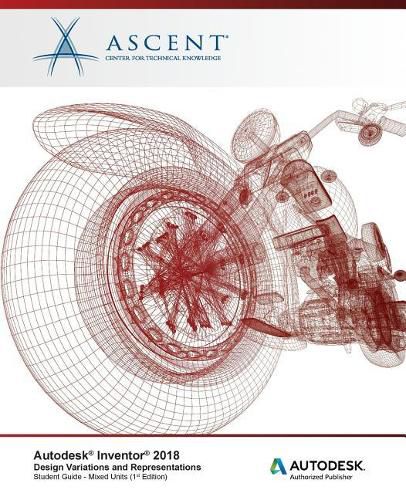Readings Newsletter
Become a Readings Member to make your shopping experience even easier.
Sign in or sign up for free!
You’re not far away from qualifying for FREE standard shipping within Australia
You’ve qualified for FREE standard shipping within Australia
The cart is loading…






The Autodesk® Inventor® 2018: Design Variations and Representations student guide contains topics that teach how to efficiently create and represent designs based on existing geometry. You will learn how the iFeature, iPart, and iAssembly tools can leverage existing geometry to quickly create additional or slightly varied geometry. Additionally, how iMates can be used to for placement in an assembly. The remaining chapters focus on how you can create positional configurations to evaluate a components’ range of motion (Positional Representations), create simplified geometry to share with customers while protecting your intellectual property (Shrinkwrap and Assembly Simplification), and how to manage large assemblies (Level of Detail Representations).
The topics covered in this student guide are also covered in the following ASCENT student guides, which include a broader range of advanced topics:
Autodesk® Inventor® 2018: Advanced Assembly Modeling Autodesk® Inventor® 2018: Advanced Part Modeling
Topics Covered
Create and place an iFeature. Use the Copy command to duplicate features in or between models. Create and edit a table-driven iFeature. Create an iPart that can generate different configurations of a model. Insert standard or custom iParts into an assembly. Modify an iPart factory. Use a table-driven iPart to create an iFeature. Build iMate constraints into parts or subassemblies. Manually or automatically match iMates of parts in an assembly and use a Match List. Vary constraint settings in iParts by including iMates. Create, place, and edit an iAssembly. Create and edit different positional representations of an assembly. Create a Shrinkwrap part. Selectively determine which components to include in a simplified view and use that information to create a new part model. Define bounding box or cylindrical geometry to represent assembly components and use that information to create a new part model. Combine the use of a simplified view, envelopes, and visibility settings to create a new simplified model. Create user-defined LOD Representations in an assembly. Replace a complex component for a simpler one using a Substitute Level of Detail Representation.
Prerequisites
The material covered in this student guide assumes a mastery of Autodesk Inventor basics as taught in the Autodesk Inventor: Introduction to Solid Modeling student guide.
$9.00 standard shipping within Australia
FREE standard shipping within Australia for orders over $100.00
Express & International shipping calculated at checkout
The Autodesk® Inventor® 2018: Design Variations and Representations student guide contains topics that teach how to efficiently create and represent designs based on existing geometry. You will learn how the iFeature, iPart, and iAssembly tools can leverage existing geometry to quickly create additional or slightly varied geometry. Additionally, how iMates can be used to for placement in an assembly. The remaining chapters focus on how you can create positional configurations to evaluate a components’ range of motion (Positional Representations), create simplified geometry to share with customers while protecting your intellectual property (Shrinkwrap and Assembly Simplification), and how to manage large assemblies (Level of Detail Representations).
The topics covered in this student guide are also covered in the following ASCENT student guides, which include a broader range of advanced topics:
Autodesk® Inventor® 2018: Advanced Assembly Modeling Autodesk® Inventor® 2018: Advanced Part Modeling
Topics Covered
Create and place an iFeature. Use the Copy command to duplicate features in or between models. Create and edit a table-driven iFeature. Create an iPart that can generate different configurations of a model. Insert standard or custom iParts into an assembly. Modify an iPart factory. Use a table-driven iPart to create an iFeature. Build iMate constraints into parts or subassemblies. Manually or automatically match iMates of parts in an assembly and use a Match List. Vary constraint settings in iParts by including iMates. Create, place, and edit an iAssembly. Create and edit different positional representations of an assembly. Create a Shrinkwrap part. Selectively determine which components to include in a simplified view and use that information to create a new part model. Define bounding box or cylindrical geometry to represent assembly components and use that information to create a new part model. Combine the use of a simplified view, envelopes, and visibility settings to create a new simplified model. Create user-defined LOD Representations in an assembly. Replace a complex component for a simpler one using a Substitute Level of Detail Representation.
Prerequisites
The material covered in this student guide assumes a mastery of Autodesk Inventor basics as taught in the Autodesk Inventor: Introduction to Solid Modeling student guide.